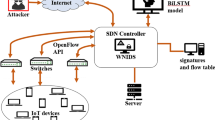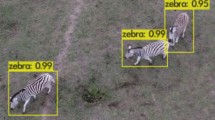Abstract
Innovative wireless technology trends and applications have attracted an incredible number of users resulting in the massive utilization of the unlicensed ISM bands. In order to accommodate the existing ISM users and to ensure optimal spectrum sharing amongst heterogeneous wireless technologies, spectrum awareness would be of keen importance in identifying concurrent transmission and subsequently applying suitable interference mitigation techniques to ensure coexistence and prevent communication blackout. Our work uses deep learning to identify the presence of WSN, WiFi and Bluetooth single-label signals. Furthermore, we aim to identify multi-label concurrent signal transmissions that are significant in the context of interference management. The experimental results show that the proposed approach yields an average classification accuracy of up to 99.9% and 99.4% for single-label and multi-label signal classification respectively. Moreover, we investigated the effect of data representations (raw data and image data), time–frequency signal representations (spectrogram and Fourier synchrosqueezed transform), color space (RGB images and grayscale images) and various deep learning models for signal classification.




















Similar content being viewed by others
References
Bajracharya, R., Shrestha, R., & Jung, H. (2020). Future is unlicensed: Private 5G unlicensed network for connecting industries of future. Sensors, 20(10), 2774. https://doi.org/10.3390/s20102774
Garroppo, R. G., Gazzarrini, L., Giordano, S. & Tavanti, L. (2011). Experimental assessment of the coexistence of Wi-Fi, ZigBee, and bluetooth devices. in 2011 IEEE International Symposium on a World of Wireless, Mobile and Multimedia Networks, Lucca, Italy, pp. 1–9. https://doi.org/10.1109/WoWMoM.2011.5986182.
Shuaib, K., Boulmalf, M., Sallabi, F. & Lakas, A. (2006). Co-existence of Zigbee and WLAN-a performance study. in 2006 IFIP International Conference on Wireless and Optical Communications Networks, IEEE. pp. 5.
Maglogiannis, V., Shahid, A., Naudts, D., De Poorter, E., & Moerman, I. (2019). Enhancing the coexistence of LTE and Wi-Fi in unlicensed spectrum through convolutional neural networks. IEEE Access, 7, 28464–28477. https://doi.org/10.1109/ACCESS.2019.2902035
Su, Y., Du, X., Huang, L., Gao, Z., & Guizani, M. (2018). LTE-U and Wi-Fi coexistence algorithm based on Q-learning in multi-channel. IEEE Access, 6, 13644–13652. https://doi.org/10.1109/ACCESS.2018.2803258
Suzain, A., Rashid, R. A., Sarijari, M. A., Abdullah, A. S., & Aziz, O. A. (2020). Machine learning based lightweight interference mitigation scheme for wireless sensor network. TELKOMNIKA, 18(4), 1762–1770. https://doi.org/10.12928/telkomnika.v18i4.14879
Hermans, F., Rensfelt, O., Voigt, T., Ngai, E., Norden, L.-Å. & Gunningberg, P. (2013). SoNIC: Classifying interference in 802.15.4 sensor networks. in Proceedings of the 12th International Conference on Information Processing in Sensor Networks–IPSN ’13, Philadelphia, Pennsylvania, USA, p. 55. https://doi.org/10.1145/2461381.2461392.
Iyer, V., Hermans, F., & Voigt, T. (2015). Detecting and avoiding multiple sources of interference in the 2.4 GHz spectrum. In T. Abdelzaher, N. Pereira, & E. Tovar (Eds.), Wireless sensor networks (Vol. 8965, pp. 35–51). Springer International Publishing. https://doi.org/10.1007/978-3-319-15582-1_3
Grimaldi, S., Martenvormfelde, L., Mahmood, A., & Gidlund, M. (2020). Onboard spectral analysis for low-complexity IoT devices. IEEE Access, 8, 43027–43045. https://doi.org/10.1109/ACCESS.2020.2977842
Huang, J., Xing, G., Zhou, G. & Zhou, R. (2010). Beyond co-existence: Exploiting WiFi white space for Zigbee performance assurance. in The 18th IEEE International Conference on Network Protocols, Kyoto, Japan, pp. 305–314. https://doi.org/10.1109/ICNP.2010.5762779.
Zhao, Z., Dong, W., Chen, G., Min, G., Gu, T., & Bu, J. (2017). Embracing corruption burstiness: Fast error recovery for ZigBee under Wi-Fi interference. IEEE Transactions on Mobile Computing, 16(9), 2518–2530. https://doi.org/10.1109/TMC.2016.2630696
Hithnawi, A., Li, S., Shafagh, H., Gross, J. & Duquennoy, S. (2016). CrossZig: Combating cross-technology interference in low-power wireless networks. in 2016 15th ACM/IEEE International Conference on Information Processing in Sensor Networks (IPSN), Vienna, Austria, pp. 1–12. https://doi.org/10.1109/IPSN.2016.7460663.
Laurent, N., Meignen, S., Fontecave-Jallon, J. & Rivet, B. (2021). A novel algorithm for heart rate estimation based on synchrosqueezing transform. in 2021 29th European Signal Processing Conference (EUSIPCO), pp. 1286–1290. https://doi.org/10.23919/EUSIPCO54536.2021.9616306.
Yavari, E., Rahman, A., Xu, J., Mandic, D. P. & Boric-Lubecke, O. (2016). Synchrosqueezing an effective method for analyzing Doppler radar physiological signals. in 2016 38th Annual International Conference of the IEEE Engineering in Medicine and Biology Society (EMBC), pp. 263–266. https://doi.org/10.1109/EMBC.2016.7590690.
Dey, A., Xu, B., Lu, X., & Sharma, N. (2022). GNSS code multipath time-frequency analysis using wavelet-based synchrosqueezing transform in Urban environments. IEEE Geoscience & Remote Sensing Letters, 19, 1–5. https://doi.org/10.1109/LGRS.2022.3167738
Wang, P., Gao, J., & Wang, Z. (2014). Time-frequency analysis of seismic data using synchrosqueezing transform. IEEE Geoscience & Remote Sensing Letters, 11(12), 2042–2044. https://doi.org/10.1109/LGRS.2014.2317578
Samuel, A. L. (1959). Some studies in machine learning using the game of checkers. IBM Journal of Research & Development, 3(3), 210–229. https://doi.org/10.1147/rd.33.0210
Zangenehnejad, F., & Gao, Y. (2021). GNSS smartphones positioning: Advances, challenges, opportunities, and future perspectives. Satellite Navigation, 2(1), 24. https://doi.org/10.1186/s43020-021-00054-y
Amatriain, X. (2013). Big & personal: Data and models behind netflix recommendations. in Proceedings of the 2nd International Workshop on Big Data, Streams and Heterogeneous Source Mining Algorithms, Systems, Programming Models and Applications–BigMine ’13, Chicago, Illinois, pp. 1–6. https://doi.org/10.1145/2501221.2501222.
Rajendran, S., et al. (2018). Electrosense: Open and big spectrum data. IEEE Communications Magazine, 56(1), 210–217. https://doi.org/10.1109/MCOM.2017.1700200
Schmidt, M., Block, D. & Meier, U. (2017). Wireless interference identification with convolutional neural networks. in 2017 IEEE 15th International Conference on Industrial Informatics (INDIN), Emden, pp. 180–185. https://doi.org/10.1109/INDIN.2017.8104767.
Grimaldi, S., Mahmood, A. & Gidlund, M. (2021). Real-time interference identification via supervised learning: Embedding coexistence awareness in IoT devices. arXiv:1809.10085 [eess], Accessed: Jun. 29, 2021. [Online]. Available: http://arxiv.org/abs/1809.10085.
Kulin, M., Kazaz, T., Moerman, I., & De Poorter, E. (2018). End-to-end learning from spectrum data: A deep learning approach for wireless signal identification in spectrum monitoring applications. IEEE Access, 6, 18484–18501. https://doi.org/10.1109/ACCESS.2018.2818794
Hasan, A., & Khan, B. M. (2022). Coexistence Management in wireless networks-a survey. IEEE Access, 10, 1–1. https://doi.org/10.1109/ACCESS.2022.3165223
O’Shea, T. J., Roy, T. & Erpek, T. (2017). Spectral detection and localization of radio events with learned convolutional neural features. in 2017 25th European Signal Processing Conference (EUSIPCO), Kos, Greece, pp. 331–335. https://doi.org/10.23919/EUSIPCO.2017.8081223.
Liu, W., Kulin, M., Kazaz, T., Shahid, A., Moerman, I., & De Poorter, E. (2017). Wireless technology recognition based on rssi distribution at sub-nyquist sampling rate for constrained devices. Sensors, 17(9), 2081. https://doi.org/10.3390/s17092081
Rajendran, S., Meert, W., Lenders, V., & Pollin, S. (2019). Unsupervised wireless spectrum anomaly detection with interpretable features. IEEE Transactions on Cognitive Communications & Networking, 5(3), 637–647. https://doi.org/10.1109/TCCN.2019.2911524
Ren, J., Zhang, X. & Xin, Y. (2019). Using deep convolutional neural network to recognize LTE uplink interference. in 2019 IEEE Wireless Communications and Networking Conference (WCNC), Marrakesh, Morocco, pp. 1–6. https://doi.org/10.1109/WCNC.2019.8885870.
Fontaine, J., et al. (2019). Towards low-complexity wireless technology classification across multiple environments. Ad Hoc Networks, 91, 101881. https://doi.org/10.1016/j.adhoc.2019.101881
Selim, A., Paisana, F., Arokkiam, J. A., Zhang, Y., Doyle, L. & DaSilva, L. A. (2017). Spectrum monitoring for radar bands using deep convolutional neural networks. in GLOBECOM 2017–2017 IEEE Global Communications Conference, Singapore, pp. 1–6. https://doi.org/10.1109/GLOCOM.2017.8254105.
Tekbıyık, K., Akbunar, Ö., Ekti, A. R., Görçin, A., Kurt, G. K. & Qaraqe, K. A. (2021). Spectrum sensing and signal identification with deep learning based on spectral correlation function. arXiv:2003.08359 [cs, eess, stat], Accessed: Feb. 15, 2022. [Online]. Available: http://arxiv.org/abs/2003.08359.
Girmay, M., Shahid, A., Maglogiannis, V., Naudts, D., & Moerman, I. (2021). Machine learning enabled Wi-Fi saturation sensing for fair coexistence in unlicensed spectrum. IEEE Access, 9, 42959–42974. https://doi.org/10.1109/ACCESS.2021.3066052
Lees, W. M., Wunderlich, A., Jeavons, P. J., Hale, P. D., & Souryal, M. R. (2019). Deep learning classification of 3.5-GHz band spectrograms with applications to spectrum sensing. IEEE Transactions on Cognitive Communications & Networking, 5(2), 224–236. https://doi.org/10.1109/TCCN.2019.2899871
Bhatti, F. A., Khan, M. J., Selim, A., & Paisana, F. (2021). Shared Spectrum monitoring using deep learning. IEEE Transactions on Cognitive Communications & Networking, 7(4), 1171–1185. https://doi.org/10.1109/TCCN.2021.3071149
Wang, J., Jiang, C., Zhang, H., Ren, Y., Chen, K.-C., & Hanzo, L. (2020). Thirty years of machine learning: The road to pareto-optimal wireless networks. IEEE Communications Surveys & Tutorials, 22(3), 1472–1514. https://doi.org/10.1109/COMST.2020.2965856
Kulin, M., Kazaz, T., De Poorter, E., & Moerman, I. (2021). A Survey on machine learning-based performance improvement of wireless networks: PHY, MAC and network layer. Electronics, 10(3), 318. https://doi.org/10.3390/electronics10030318
O’Shea, T. J., Corgan, J. & Clancy, T. C. (2016). Convolutional radio modulation recognition networks. arXiv:1602.04105 [cs], Accessed: Apr. 20, 2022. [Online]. Available: http://arxiv.org/abs/1602.04105.
Yi et al., S. (2018). Interference source identification for IEEE 802.15.4 wireless sensor networks using deep learning. in 2018 IEEE 29th Annual International Symposium on Personal, Indoor and Mobile Radio Communications (PIMRC), Bologna, Italy, pp. 1–7.https://doi.org/10.1109/PIMRC.2018.8580857.
Zhang, X., Seyfi, T., Ju, S., Ramjee, S., Gamal, A. E. & Eldar, Y. C. (2019). Deep learning for interference identification: Band, training SNR, and sample selection. in 2019 IEEE 20th International Workshop on Signal Processing Advances in Wireless Communications (SPAWC), Cannes, France, pp. 1–5. https://doi.org/10.1109/SPAWC.2019.8815481.
Subray, S., Tschimben, S., & Gifford, K. (2021). Towards enhancing spectrum sensing: Signal classification using autoencoders. IEEE Access, 9, 82288–82299. https://doi.org/10.1109/ACCESS.2021.3087113
Chen, H., & Kim, S.-J. (2021). Robust RF mixture signal recognition using discriminative dictionary learning. IEEE Access, 9, 141107–141120. https://doi.org/10.1109/ACCESS.2021.3120635
Grunau, S., Block, D. & Meier, U. (2018). Multi-label wireless interference classification with convolutional neural networks. in 2018 IEEE 16th International Conference on Industrial Informatics (INDIN), Porto, pp. 187–192. https://doi.org/10.1109/INDIN.2018.8471956.
Shahid, A. et al., (2019) A convolutional neural network approach for classification of LPWAN technologies: Sigfox, LoRA and IEEE 802.15.4g. in 2019 16th Annual IEEE International Conference on Sensing, Communication, and Networking (SECON), Boston, MA, USA, pp. 1–8. https://doi.org/10.1109/SAHCN.2019.8824856.
O’Mahony, G. D., Harris, P. J. & Murphy, C. C. (2020). Identifying distinct features based on received samples for interference detection in wireless sensor network edge devices. in 2020 Wireless Telecommunications Symposium (WTS), Washington, DC, USA, pp. 1–7. https://doi.org/10.1109/WTS48268.2020.9198724.
O’Mahony, G. D., McCarthy, K. G., Harris, P. J., & Murphy, C. C. (2021). Developing novel low complexity models using received in-phase and quadrature-phase samples for interference detection and classification in wireless sensor network and GPS edge devices. Ad Hoc Networks, 120, 102562. https://doi.org/10.1016/j.adhoc.2021.102562
Zhang, W., Feng, M., Krunz, M. & Hossein Yazdani Abyaneh, A. (2021). Signal detection and classification in shared spectrum: A deep learning approach. in IEEE INFOCOM 2021–IEEE Conference on Computer Communications, Vancouver, BC, Canada, pp. 1–10. https://doi.org/10.1109/INFOCOM42981.2021.9488834.
Auger, F., et al. (2013). Time-frequency reassignment and synchrosqueezing: An overview. IEEE Signal Processing Magazine, 30(6), 32–41. https://doi.org/10.1109/MSP.2013.2265316
Oberlin, T., Meignen, S. & Perrier, V. (2014). The fourier-based synchrosqueezing transform. in 2014 IEEE International Conference on Acoustics, Speech and Signal Processing (ICASSP), Florence, Italy, pp. 315–319. https://doi.org/10.1109/ICASSP.2014.6853609.
Zhang, M., Diao, M., & Guo, L. (2017). Convolutional neural networks for automatic cognitive radio waveform recognition. IEEE Access, 5, 11074–11082. https://doi.org/10.1109/ACCESS.2017.2716191
Acknowledgements
The authors would like to acknowledge Schmidt et al.[21] for sharing the CRAWDAD owl/interference dataset.
Author information
Authors and Affiliations
Corresponding author
Ethics declarations
Conflict of interest
The authors have no conflict of interest to declare.
Additional information
Publisher's Note
Springer Nature remains neutral with regard to jurisdictional claims in published maps and institutional affiliations.
Glossary
- WSN
-
Wireless sensor networks
- Single-label signal
-
Radio samples in which one signal is present at a time
- Multi-label signal/Mixture Signal
-
Radio samples in which multiple concurrent signals are present at a time
- WII
-
Wireless interference identification
- WTR
-
Wireless technology recognition
- TFR
-
Time–frequency representation/spectral plot
- STFT
-
Short Time fourier transform
- Spectrogram
-
STFT based spectral plot
- FSST
-
Fourier synchrosqueezing transform
- CNN
-
Convolutional neural networks
Rights and permissions
Springer Nature or its licensor (e.g. a society or other partner) holds exclusive rights to this article under a publishing agreement with the author(s) or other rightsholder(s); author self-archiving of the accepted manuscript version of this article is solely governed by the terms of such publishing agreement and applicable law.
About this article
Cite this article
Hasan, A., Khan, B.M. Deep learning aided wireless interference identification for coexistence management in the ISM bands. Wireless Netw 29, 3311–3331 (2023). https://doi.org/10.1007/s11276-023-03389-3
Accepted:
Published:
Issue Date:
DOI: https://doi.org/10.1007/s11276-023-03389-3




